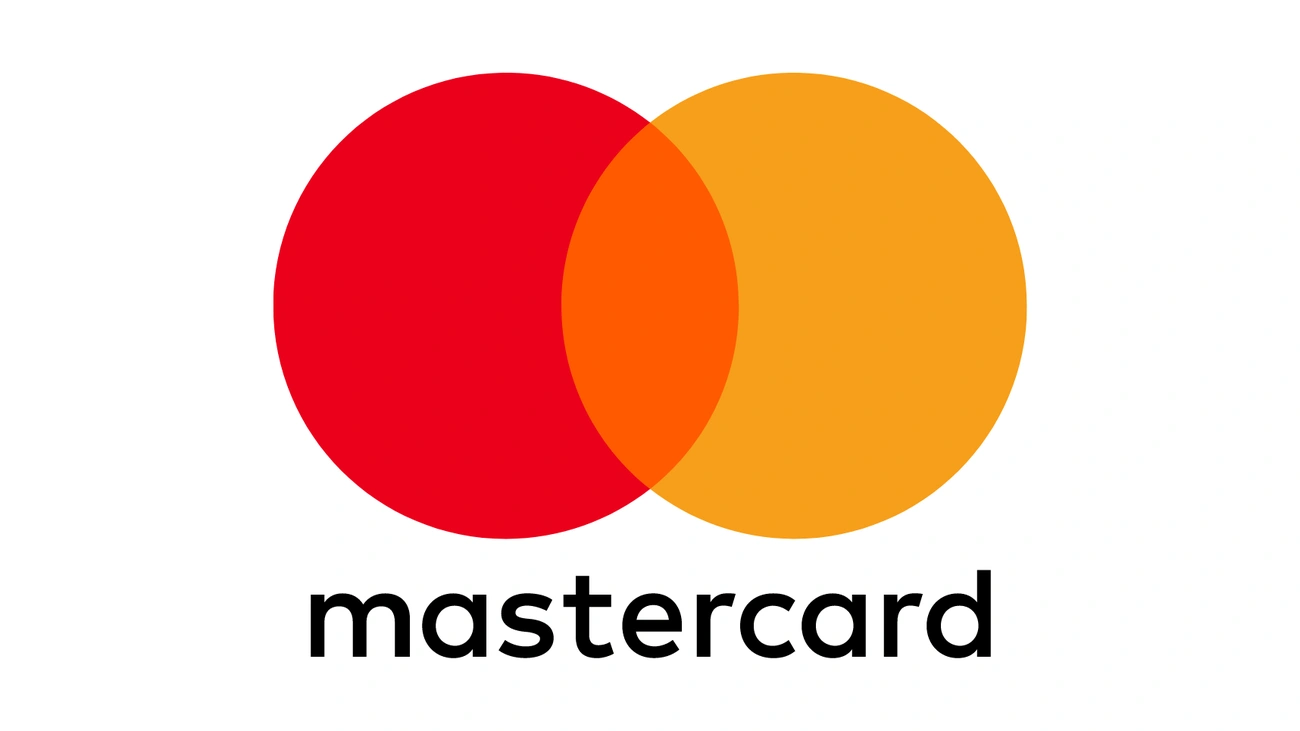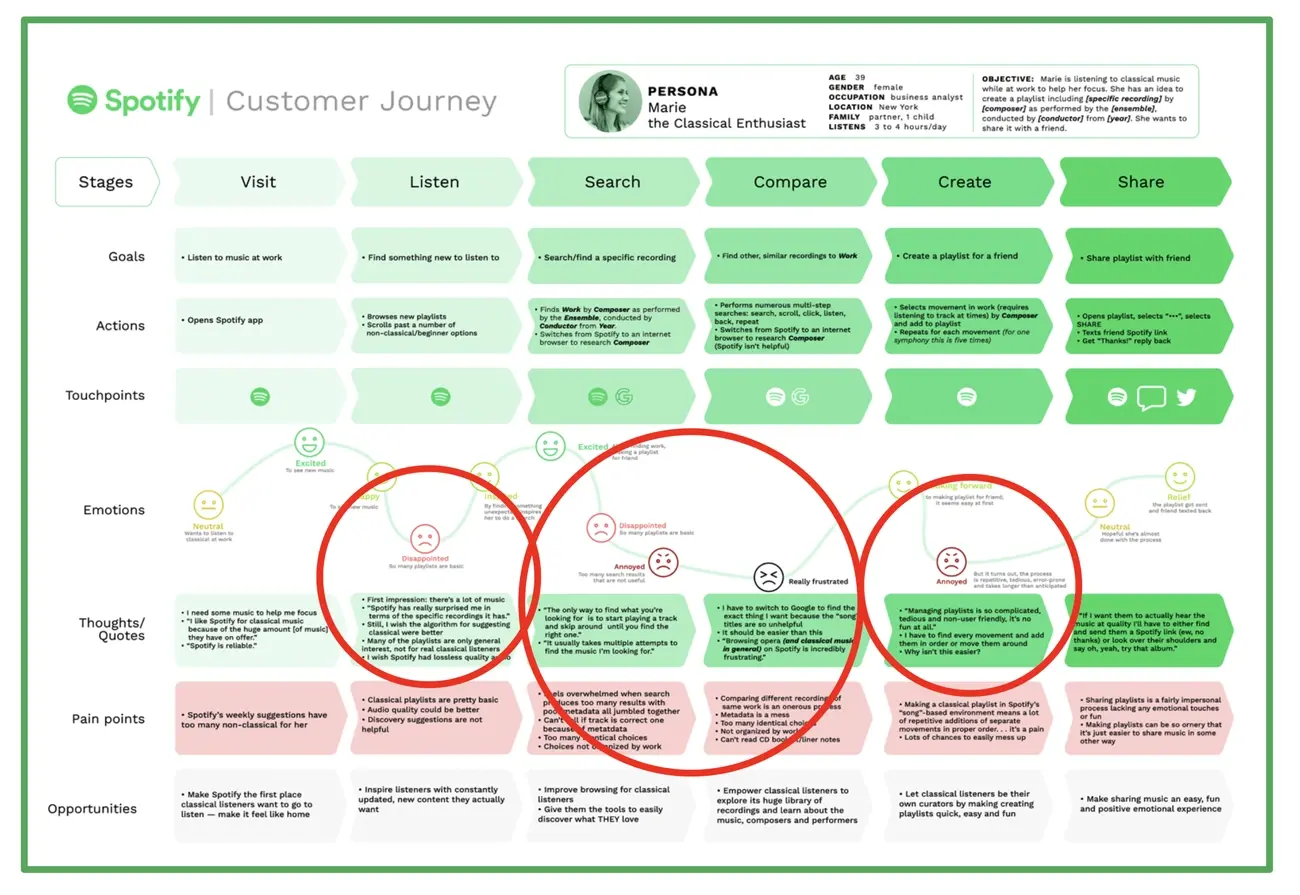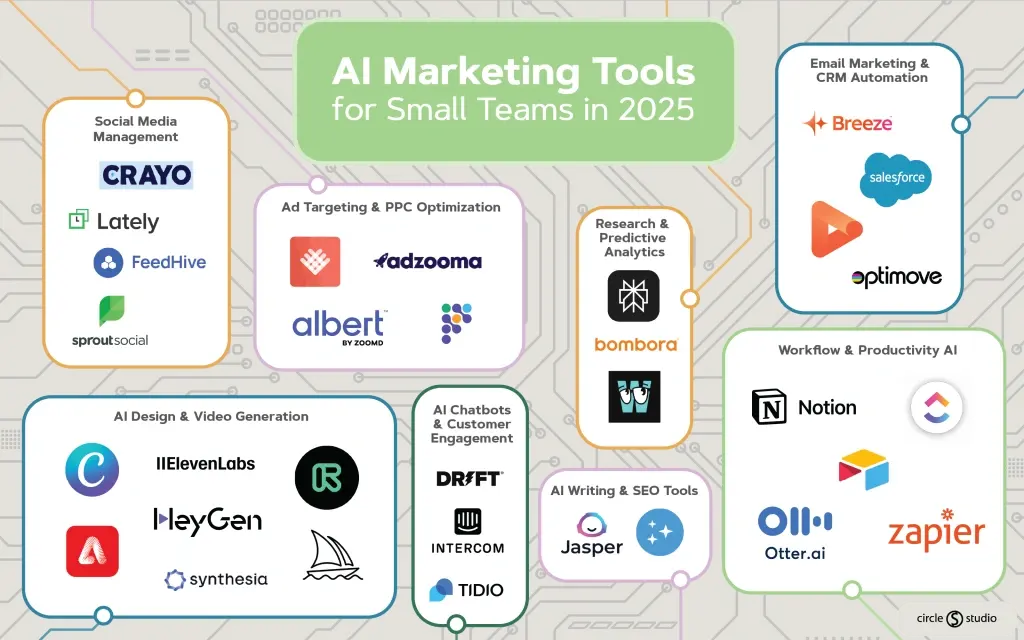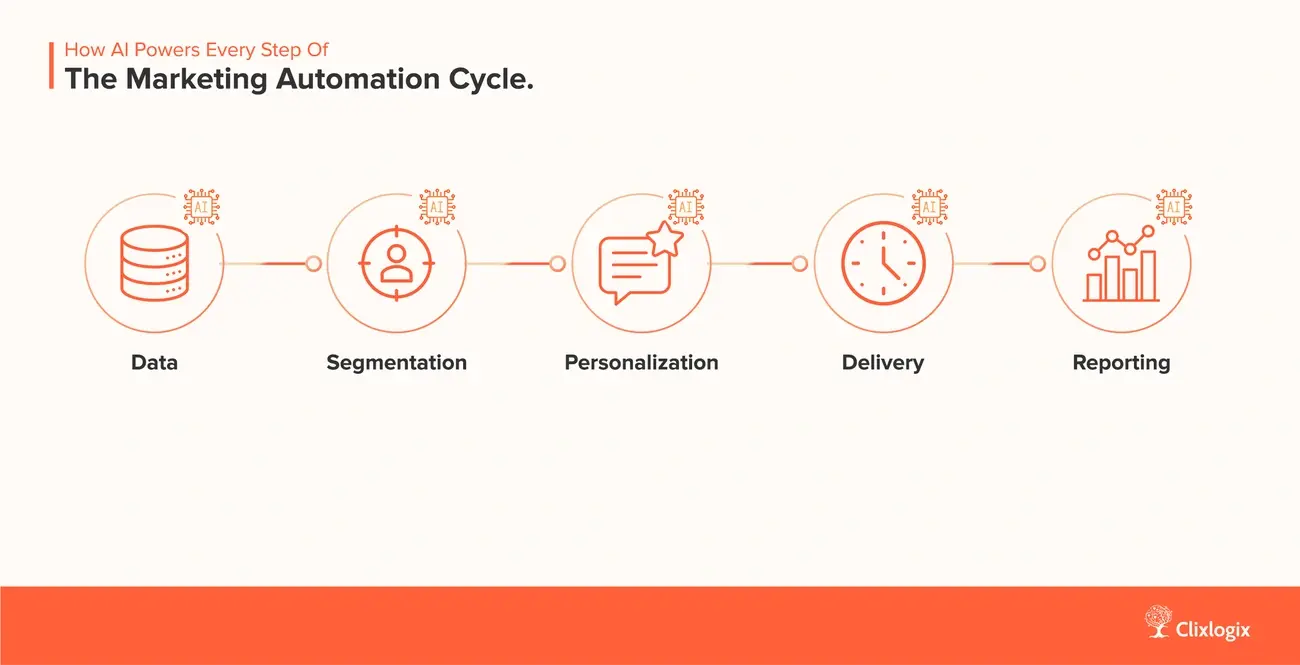
Ingrida Šilobrit
AI & Automation Specialist
Real-world examples of how companies like Mastercard, Spotify, and Netflix used AI marketing automation to double ROI, improve targeting, and scale campaigns smarter.

The global AI marketing automation market hit $184 billion at the start of 2025, jumping nearly $50 billion since 2023. This isn't just market excitement—it's driven by companies seeing real returns on their automation investments.
McKinsey's 'State of AI 2025' report shows more than three-quarters of organizations now use AI in at least one business function. The reason is simple: AI marketing automation handles the repetitive work—audience segmentation, copy creation, campaign scheduling—while machine learning and predictive analytics deliver faster execution, better targeting, and measurable ROI.
Seven companies proved this point by doubling their marketing returns using AI-powered automation tools. These businesses didn't just speed up their marketing operations. They built deeper customer connections and turned AI from a competitive edge into standard business practice.
Here's how they did it.

Mastercard spotted a critical marketing challenge: by the time most companies identify trending topics, the moment has passed. Their solution? An AI system that catches micro-trends as they emerge and launches campaigns within minutes instead of months.
Mastercard's approach centers on their decision management platform—the AI brain that already prevented over $20 billion in fraud in just 12 months. The company expanded this same AI capability to power their marketing operations.
Their strategy relies on a two-tier evaluation system. First, an AI review board with experts from legal, privacy, product, and business teams evaluates each project's intent and ethical implications. Then comes technical assessment for scalability and ROI potential.
Ed McLaughlin, President and CTO of Mastercard, puts it simply: "AI has been an essential capability for Mastercard for years now, and we see it only increasing in importance and impact". The key difference? They test new AI techniques in silent mode alongside existing systems before full deployment.
The Mastercard Digital Engine processes billions of internet conversations worldwide, identifying micro-trends in real-time. Think emerging food trends like sushi burritos or shifts in how people prefer to pay.
Once the system spots a trend, it instantly matches it with Mastercard's experiences and offers across culinary, travel, sports, music, and entertainment categories. Marketers get deep trend analysis to decide whether to launch campaigns with Mastercard Priceless experiences.
Speed sets this system apart—campaigns launch across multiple platforms in minutes rather than months. When a trend peaks, the system automatically terminates campaigns to keep all marketing timely and relevant.
The AI uses three core processes:
These algorithms get refined using Word Mover's Distance, Isolation Forest, and One Class SVM to filter out irrelevant micro-trends. Cheryl Guerin of Mastercard calls this a "real-time marketing engine" that tracks cultural and behavioral signals to fuel campaigns around emerging passions.
Mastercard's AI-driven campaigns delivered measurable returns. One two-day campaign using the Digital Engine achieved:
Over two years, Mastercard launched more than 500 successful campaigns across 20 countries. Statistical analysis revealed impressive performance ranges:
Cost efficiencies proved equally compelling:
The Latin American market, where the engine sees extensive use, showed an eight percentage point improvement in positive brand sentiment. These results prove how AI marketing automation can transform campaign performance while building stronger brand connections.

Music streaming giant Spotify faced a critical challenge: how do you keep 450 million users engaged when they have access to over 100 million songs? Their answer: predictive AI that maps individual customer journeys before users even know where they're heading.
Spotify built their success on understanding what users want before users understand it themselves. The platform tracks extensive data from every interaction—listening habits, search behavior, playlist creation, location data, and device usage patterns. This information feeds into their prediction engine that delivers content users didn't know they needed.
The system operates on three core predictive models:
These models do more than suggest the next song. Spotify's AI monitors engagement patterns to predict subscription cancellations, allowing the platform to intervene with targeted retention offers before users even consider leaving. Each interaction makes the system smarter, creating increasingly accurate predictions.
Spotify's ai marketing automation tools create seamless customer journeys that feel effortless to users but require sophisticated technology behind the scenes. The platform's tech stack enables advertisers to deploy video, display, and AI-powered audio production tools that target specific moments in the user experience.
Their programmatic advertising platform uses AI to serve personalized ads based on listening history, location, and demographic data. The result: ads that feel relevant rather than intrusive, maximizing both user experience and advertiser returns.
The journey mapping system excels at:
Spotify Wrapped exemplifies this approach—turning user data into shareable content that drives organic marketing while strengthening brand loyalty.
The financial results speak for themselves. Spotify's AI-driven advertising approach delivered measurable improvements:
These improvements helped generate record-breaking revenue. In 2024 alone, Spotify paid $10 billion to the music industry, totaling nearly $60 billion since launch.
Their AI-driven monetization extends beyond subscriptions. The platform creates additional revenue through targeted advertising initiatives and strategic partnerships with artists and brands. This approach builds a self-reinforcing cycle: better user experiences increase retention, which generates more data for accurate predictions, which improves personalization and advertiser ROI.
Spotify proved that predictive customer journey mapping isn't just about recommendation algorithms—it's about building a business model where AI-driven personalization becomes the competitive advantage.

Netflix cracked the code on content promotion by going beyond basic engagement metrics. Their AI marketing automation eliminates guesswork in content investment through transfer learning—an advanced technique that applies insights from one task to improve performance on related challenges.
Netflix built their marketing ecosystem around machine learning models, data infrastructure, and continuous testing that personalizes every user touchpoint. This goes far beyond recommending the next show—it's about promoting content strategically to maximize viewer engagement and retention.
The streaming platform deploys AI-powered automation across their entire marketing operation:
These systems work together as an interconnected decision-making framework that guides both content creation and promotion strategies.
Netflix's transfer learning implementation sets them apart from traditional recommendation systems. They apply knowledge gained from viewing pattern analysis to inform both marketing decisions and content investments.
When greenlighting House of Cards, Netflix used transfer learning to uncover three critical insights: strong viewership of the original British version among subscribers, overlap between viewers of the British version and fans of Kevin Spacey films or David Fincher's directorial work, and higher completion rates among Fincher film viewers who showed single-sitting viewing behavior.
Their transfer learning approach works through cross-domain knowledge application, where seemingly unrelated data points inform promotion strategies. Netflix also employs transfer learning models to evaluate screenplays for structural and qualitative factors, comparing script elements against patterns observed in previously successful titles. Their automated systems generate and test promotional assets, learning from each interaction to optimize future campaigns.
Netflix's personalization engine saves the company over $1 billion annually in customer retention costs. This represents a core financial asset that underpins their entire business model.
Netflix transformed content greenlighting from creative guesswork into data-driven decision-making. With their projected $18 billion content investment for 2025, even small improvements in success rates generate enormous financial returns.
The company tracks specific performance indicators that demonstrate marketing ROI: Marketing ROI formula calculation (Attributable Revenue – Campaign Cost) / Campaign Cost, engagement lift between exposed and non-exposed segments, and cost per engagement across marketing channels. This approach ensures their massive content investments deliver maximum returns through precisely targeted promotion to the right audience segments.

Project management platform ClickUp solved a problem most marketing teams know too well—turning SEO from guesswork into predictable results. Their AI-powered approach goes beyond basic keyword research to create complete SEO strategies that actually work.
ClickUp Brain sits at the center of their content intelligence system. This AI solution analyzes trends, competitor data, and search intent to generate keywords that matter for specific niches.
The system handles three key areas where teams typically waste time:
ClickUp Brain contextualizes keyword insights beyond traditional tools, helping marketers prioritize which terms to target and how to structure them within content.
ClickUp integrates with SurferSEO to create a complete SEO optimization system. Teams make data-driven decisions about content creation and optimization based on actual search performance metrics.
The implementation process works like this:
The system identifies trending topics by analyzing vast datasets quickly. It predicts audience preferences using algorithms and provides insights into competitor strategies for planning.
When content is ready for optimization, the platform helps marketers:
Teams access everything in one centralized workspace instead of juggling multiple disconnected platforms for keyword research, content planning, and performance tracking.
The financial results speak for themselves. According to a Forrester Total Economic Impact study, organizations using ClickUp achieved 384% Return on Investment over three years.
Teams implementing these AI marketing approaches saw a 7x increase in output in some departments. Organizations also reduced legacy software costs by 60% by year 3, saving approximately $114,000.
Companies using ClickUp for SEO automation report client satisfaction scores above 90% due to faster response times and better issue tracking. The centralized approach to SEO and content intelligence helps marketing teams execute campaigns with greater precision, driving substantial organic traffic growth.

Social media powerhouse Meta built one of the industry's most advanced AI sandboxes for creative testing. Their advertising platform helps marketers break through traditional creative limitations and achieve measurable performance gains.
Meta's AI Sandbox operates as a complete creative optimization ecosystem. At its core sits GEM (Generative Ads Recommendation Model), a foundation model that enhances ad relevance across all platforms. Meta calls this their "central brain" that accelerates ads recommendation innovation.
The system delivers three key capabilities:
Meta plans to enable brands to fully create and target ads using AI by the end of next year. This shifts how marketers approach creative development—from manual production to AI-guided optimization.
Meta's AI enables advertisers to generate and test multiple creative variants simultaneously. The system identifies targetable audiences based on performance data, consumer interactions with similar ads, and engagement patterns across Instagram, Messenger, and Facebook.
GEM uses several advanced techniques:
Meta employs direct and hierarchical knowledge transfer strategies, using knowledge distillation, representation learning, and parameter sharing to maximize transfer efficiency. This approach achieves twice the effectiveness of standard knowledge distillation methods.
The financial results from these ai marketing examples have been significant. Since launching GEM earlier this year, Meta documented specific performance improvements:
Recent model architecture enhancements doubled the performance benefit from adding data and compute. This efficiency breakthrough enables continued scaling of training capacity with strong ROI.
Companies using Meta's creative diversity tools report impressive results:
Through Meta's creative testing sandbox, marketers make data-driven decisions about which creative elements drive performance. They maximize both reach and conversion without expanding budgets.

Fashion giant Zara proved that AI solves real business problems. They tackled online fashion's biggest headache—fit accuracy and returns management—and built a data-driven system that pays for itself.
Zara's shopping experience runs on a sophisticated data ecosystem that tracks customer behavior patterns. The company partnered with Jetlore, a consumer behavior prediction platform, to build detailed customer behavior maps that inform production decisions. This isn't just about recommendations—it's about understanding individual preferences from color choices to fit requirements.
The system analyzes customer data streams including browsing patterns, purchase history, and style preferences to deliver targeted product suggestions. Zara invested in Natural Language Processing and computer vision models that function as AI-powered personal stylists.
Their AI tools extend beyond basic recommendations:
Zara's AI directly addresses the fashion industry's $50 billion problem with poorly fitting garments. Their size recommendation engines analyze previous purchases and customer measurements to predict optimal fit.
The company uses augmented reality for virtual try-on experiences that let shoppers visualize garments before purchasing. This reduces shopping uncertainty while encouraging purchases and cutting return rates.
Physical stores feature AI-enhanced smart mirrors that transform fitting rooms into interactive styling spaces. These mirrors display brought-in items and actively suggest complementary pieces based on established customer preferences.
Zara's AI-driven approach delivered measurable business results. Their size recommendation tools achieved substantial improvements across key metrics:
The system creates a self-reinforcing business model: accurate recommendations reduce returns, which cuts operational costs. This approach works so well that other fashion brands implemented similar technologies and achieved comparable return reductions without needing data science teams.
Zara's implementation shows how AI automation solves practical business challenges while improving the economics of online fashion retail through smarter customer experiences.

Wellness app pioneer Calm faced a common problem: users downloaded the app but struggled to find content that actually helped them sleep or reduce stress. Their solution shows how AI automation can solve real user problems instead of just pushing engagement metrics.
Calm's first recommendation system failed users completely. The app showed popular content while hiding what you'd already heard. Users clicked but rarely finished sessions. This told Calm something important—popularity doesn't equal personalization.
The problem was clear: meditation isn't one-size-fits-all. Your stress relief might come from a 5-minute breathing exercise, while someone else needs a 30-minute sleep story. Calm needed AI powered marketing automation that understood individual wellness needs, not just click patterns.
Calm deployed Amazon Personalize to build recommendations around actual user behavior. The system tracks:
What made Calm different from other AI marketing examples was their business rule engine. Instead of pushing users toward longer sessions, the system aggregated recommendations into collections and filtered by content type. It shuffled suggestions to keep things fresh, even when user behavior stayed consistent.
The results proved that AI marketing automation examples work best when they solve real problems:
Calm's approach proves a point: AI marketing campaigns don't have to maximize screen time to deliver business value. The app uses AI to help users achieve their wellness goals faster and more effectively. Better outcomes create loyal users who stick around longer and recommend the app to others.
These seven companies proved AI marketing automation delivers measurable business value when applied to specific challenges. Each solved real problems—Mastercard captured fleeting trends, Zara reduced costly returns, Netflix picked winning content investments.
The numbers show clear ROI across different industries and use cases. Financial services, entertainment, fashion, and wellness companies all doubled their marketing efficiency using targeted AI solutions. More importantly, they built sustainable competitive advantages while reducing operational costs.
Success came from focusing on business problems first, technology second. These companies didn't chase AI for its own sake. They identified workflow inefficiencies, customer experience gaps, and operational bottlenecks—then applied AI to fix those specific issues.
Smart implementation patterns emerge across all seven examples:
AI marketing automation has moved from competitive advantage to business necessity. Companies implementing these solutions systematically gain market share while reducing costs. Your marketing operations can achieve similar results through focused AI deployment.
The question isn't whether to use AI marketing automation—it's how to apply it to your specific challenges. Whether you're handling manual tasks, struggling with customer engagement, or managing complex content workflows, proven solutions exist.
Ready to identify where AI marketing automation could double your ROI? Get Your Free Automation Audit to discover opportunities specific to your business challenges.
The companies profiled here succeeded because they matched AI solutions to real business problems. Your success will come from the same approach—strategic implementation focused on measurable outcomes rather than technology for its own sake.
Q1. How is AI expected to impact marketing automation by 2025? AI is projected to significantly transform marketing automation, with global AI spend expected to reach nearly $1.50 trillion in 2025. Companies are increasingly leveraging AI for personalized experiences, predictive analytics, and automated processes to enhance efficiency and drive growth.
Q2. What are some successful examples of AI in marketing? Successful examples include Mastercard's real-time social listening for trend-based campaigns, Spotify's predictive customer journey mapping, Netflix's transfer learning for content promotion, ClickUp's SEO automation with content intelligence, and Meta's AI sandbox for creative testing.
Q3. How are companies using AI to improve ROI in marketing? Companies are using AI to improve ROI through various means, such as personalized content recommendations, predictive analytics for audience targeting, automated ad optimization, and AI-powered customer journey mapping. These implementations have led to significant improvements in engagement rates, click-through rates, and overall marketing efficiency.
Q4. What benefits can businesses expect from implementing AI in their marketing strategies? Businesses implementing AI in their marketing strategies can expect benefits such as increased engagement rates, improved targeting accuracy, reduced marketing costs, higher conversion rates, and more personalized customer experiences. For instance, some companies have reported up to 254% higher click-through rates and 85% reductions in cost per click.
Q5. How is AI revolutionizing content creation and promotion in marketing? AI is revolutionizing content creation and promotion by enabling automated content generation, predictive analytics for content performance, and personalized content recommendations. For example, Netflix uses AI to analyze viewing patterns and inform content investment decisions, while Calm uses AI to deliver tailored content recommendations, resulting in increased user engagement and retention.
Access our exclusive whitepapers, expert webinars, and in-depth articles on the latest breakthroughs and strategic implications of advanced automation and AI.